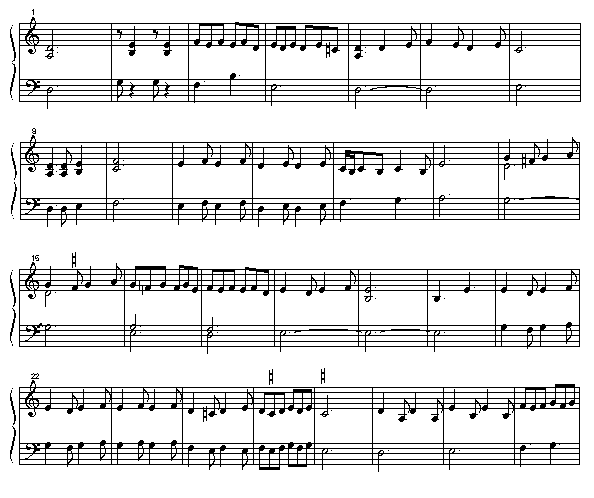
Introduction
(I) Specified chromatic inflections in vocal sources
(II) The theorists' statements> (III) Instrumental tablatures
> first part
second part
Instrumental tablatures are particularly interesting for the study of musica ficta, because for technical reasons, they (as a rule) do not confuse a given pitch with its chromatic inflection. This is only a general statement, however, which will be found to need qualification in many special cases.
Thus some types of instrumental sources can only improperly be called "tablatures", and are not fundamentally different from vocal sources with respect to pitch notation: these are the so-called "keyboard scores" and "keyboard partituras", used to notate (among others) Italian or French keyboard pieces from the fifteenth century onwards (for example the celebrated "Codex Faenza", around 1400).
Even the oldest of all types of tablatures, the old German organ tablature (documented from the fourteenth century), is not altogether unambiguous: in this type of source, the upper voice appears in mensural notation on a vocal staff, a technique which is not incompatible with implied accidentals. In this particular case, only the lower voices (which are given in letters) can be considered as being unequivocal.
Other types of tablatures, typically the Italian, German and French lute tablatures, or the Spanish vihuela tablature, are entirely unambiguous; but they do not appear before the early years of the sixteenth century.
Finally, it should be noted that, for the whole period under consideration (i.e. until about 1560-80), one will find virtually no useful Flemish or English source; indeed, the rare instrumental documents surviving from these countries tend to favour the ambiguous types of notation, which will not be adduced here, since they are not really more informative than vocal sources for our special topic of study.
Fourteenth-fifteenth centuries
For the earliest period, only German organ tablatures are available. They mainly consist of fragments, apart from the Buxheimer Orgelbuch, which seems to date approximately from the 1470s.
The fourteenth-century fragments remain rare. They already include explicit accidentals for leading notes, but presumably not in all necessary places, which could be due to the fact that the seventh degree of the scale most often appears in the top voice (which is not unambiguous in this type of source, as already explained).
ex.: Estampie (14th century)

[See APEL, Willi (ed.), Keyboard Music of the Fourteenth & Fifteenth Centuries, Rome, American Institute of Musicology, 1963 (=Corpus of Early Keyboard Music I), p. 1]
The same holds for the fifteenth century. The Buxheimer Orgelbuch, which is the principal source of German organ tablature for that century, contains many passages akin to this:
ex.: Buxheimer Orgelbuch, Vierhundert Jare
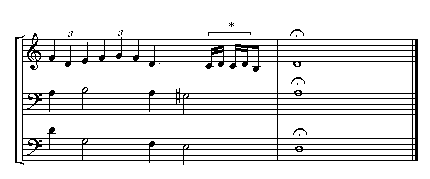
[See WALLNER, B. A. (ed.), Das Buxheimer Orgelbuch, Kassel, Bärenreiter, 1958-59, 3 vol. (=Das Erbe Deutscher Musik Bd. 37-39), vol. p. 153/5/2-3.]
Here, the addition of a leading note accidental (c sharp) in the top voice is very likely, for a diminished fourth with the middle voice (g sharp -- c natural) hardly seems to be conceivable in the musical language of the time. In this source, such cases are five times as numerous as explicit double leading note cadences; this figure yields a general estimate of the possible proportion of implied accidentals in this repertory.
Other common types of cadences in this manuscript are shown in the following example; it should be noted that, in such cases as well, only one out of four or five cadences is provided with an explicit accidental:

In spite of its earlier date, the Lochamer Liederbuch (about 1452-56) includes four instances of an augmented fourth between the upper voices:
ex.: Lochamer Liederbuch, Mit ganczem Willen
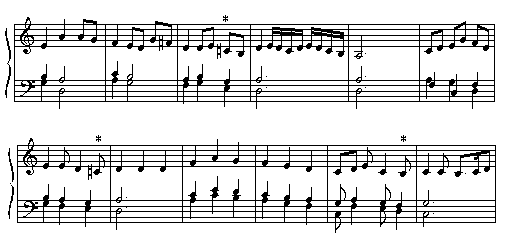
[See APEL, Willi (ed.), Keyboard Music of the Fourteenth & Fifteenth Centuries, Rome, American Institute of Musicology, 1963 (=Corpus of Early Keyboard Music I), p. 42/5/9; 42/6/4; 42/6/8; see also p. 46/6/2]
This new formula is the one which, together with the V-I cadence, was eventually to replace the double-leading note cadence. But all these different possibilities were still to appear side by side for some time in the German organ repertory, as we shortly shall see.
The sixteenth century
In the first decades of the sixteenth century, the most instructive types of tablatures at last appear: Italian, French and German lute tablatures, as well as Spanish tablatures for vihuela or keyboard. Thus the available information for this century is incomparably richer than for the two previous ones.
In all this large body of instrumental music, contradictions to the attraction principle will be found essentially in the German organ tablatures.
The German organ tablatures
As Willi Apel observed as early as 1936, modal features are not at all uncommon in the German organ tablatures of the first half of the sixteenth century. More particularly, the following formula will be found to appear quite frequently in the works of Hans Buchner (around 1530):
ex.: Hans Buchner, Quae est ista, quae ascendit
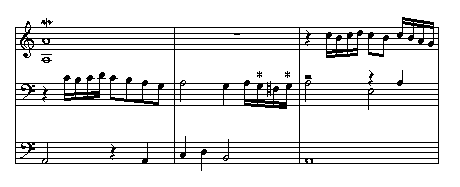
[See SCHMIDT, Jost Harro (ed.), Hans Buchner, Sämtliche Orgelwerke, Frankfurt, H. Litolff, 1974, 2 vol. (=Das Erbe deutscher Musik, 54-55), vol. 1, p. 45, bar 68]
One should of course pay particular attention to the lower voices, which are the only ones to be unambiguously notated as regards chromatic inflections. In these voices, the formula above (a modal cadence, with a subtonic which is not raised to become a leading note) represents about one fifth of the cases of II-I cadences. In other words, it is far from being an unimportant phenomenon.
In two exceptional instances, the leading note is even explicitly excluded by the addition of a chromatic inflection in the upper voice:
ex.: Hans Buchner, Puer natus in f
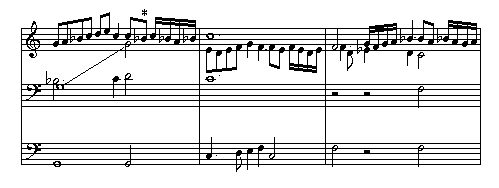
[See ibidem, p. 1, p. 39, bar 50; see also p. 41, bar 67. For all these passages, the original manuscript (which is kept in the University Library of Basle, Switzerland, ms. F I 8a) completely agrees with the modern edition. Several facsimiles of this Basle manuscript have been published in Musica Ficta, une histoire des sensibles..., p. 280-282.]
On the other hand, Buchner's tablature also contains double-leading-note cadences (which are less common), II-I cadences with an augmented fourth (or a diminished fifth) between the upper voices, and above all V-I cadences (with a leading note). As one can see, the variety of its approaches makes this source one of the most versatile in the entire instrumental literature of its time.
The same applies (but to a lesser extent) to Fridolin Sicher (1525), himself a pupil of Buchner. In the works of this composer, modal cadences between the lower voices are even more frequent than in Buchner's, as they represent about one third of the total cases. On the other hand, Sicher's tablature quite often resorts to vertical false relations, which are very rarely found in Buchner's (about twenty cases for Sicher, as against two for Buchner):
ex.: Fridolin Sicher, O pulcherrima mulierum (after Jean Mouton)
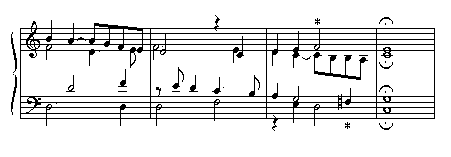
[See MARX, H. J., WARBURTON, T. (ed.), St. Galler Orgelbuch, Die Orgeltabulatur des Fridolin Sicher (St. Gallen, Codex 530), Winterthur, Amadeus Verlag, 1992, 366 p. (=Schweizerische Musikdenkmäler, Bd. 8, Tabulaturen des XVI. Jahrhunderts Teil 3), p. 108/16.]
Besides, there are reasons for believing that chromatic inflections are not always explicitly stated in Sicher's tablature, even for the lower voices -- which clearly seems to be an exceptional case:
ex.: Fridolin Sicher, [untitled] (after Jachet [of Mantua?])
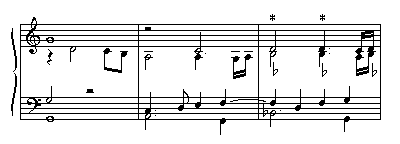
[Ibid., p. 289/27.]
Leonhard Kleber (about 1520-24) also makes use of the modal cadence, but the latter is much less common in his tablature (only a dozen examples, mainly as intermediate, non-final cadences):
ex.: Leonhard Kleber, Ave sanctissima Maria
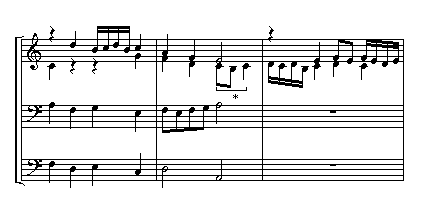
[See BERG-KOTTERBA, Karin, Die Orgeltabulatur des Leonhard Kleber, Frankfurt, Henry Litolff, 1987 (=Das Erbe Deutscher Musik, Bd. 91-92), vol. 2, p. 119/1/3.]
The same Kleber also gives four examples of simultaneous false relations, which are quite similar to those found in Sicher's tablature:
ex.: L. Kleber, Decem precepta - in sol
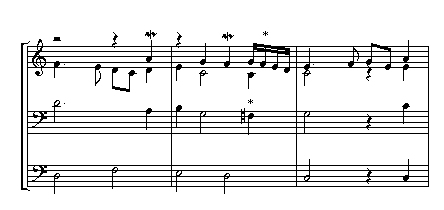
[Ibid., Vol. 2, p. 17/4/1. See also my "reply to criticisms".]
Finally, Clemens Hör's tablature (around 1535) includes even more frequent modal formulas, and virtually no explicit attraction accidental, in the lower voices as well as in the upper one. It does not contain any simultaneous false relation either. But Hör's artistic standing is all too difficult to assess; he appears to have been some kind of schoolmaster in the Swiss canton of Sankt Gallen. This might lead us to the conclusion that his testimony should not be put on the same level as Buchner's or even Kleber's.
Together, these four composers (Buchner, Sicher, Kleber and Hör) represent something like two thirds of the total collection of old German organ tablatures in the sixteenth century. Other composers by contrast (Hans Kotter, John of Lublin) do not share such modal characteristics.
Continued: (III) The tablatures (second part: other countries) >>>
© Vincent Arlettaz
- last update: 27 December 2002 -